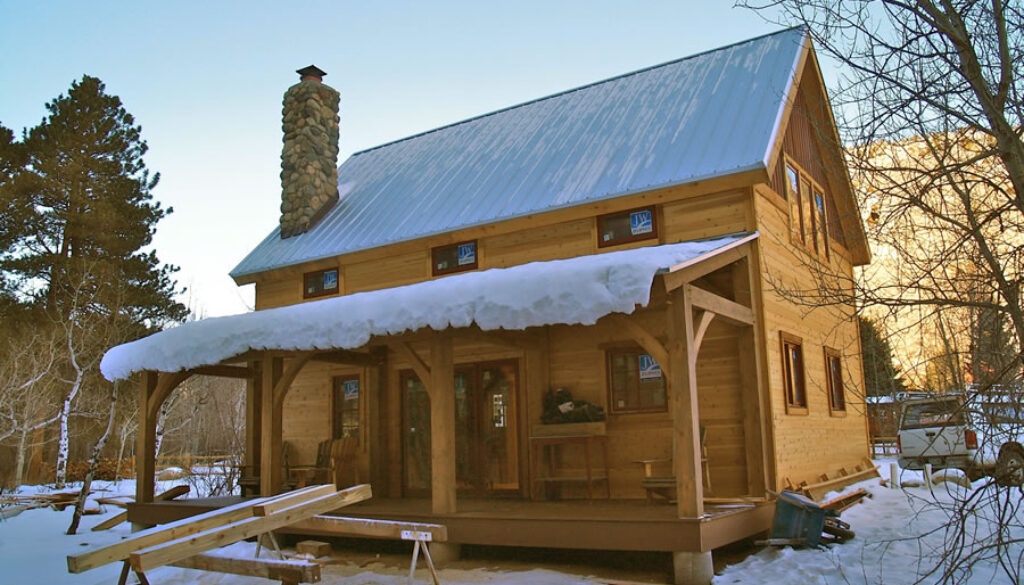Timber-frame homes can be cost-effective
Publication: Fort Collins Coloradoan
Date: June 2016
Author: Rob White
Move over million-dollar mansions, timber-frame homes can be cost-effective
When you think about timber-frame homes in Colorado, do you think of multimillion dollar getaway spots in the mountains?
Well, it’s time to think again.
“People equate timber frames to these massive, million-dollar lodges, and it doesn’t have to be that way,” said Steve Rundquist of Brewster Timber Frame. “If we can get in early enough and help design the project, we can keep things straightforward and fairly simple to help keep the cost down. The simplest frame is really beautiful.”
Rundquist learned timber framing while living in Brewster, Massachusetts, on Cape Cod in the late 1980s. When he moved to Colorado in the 1990s, he brought his business with him.
Now he, Mike DuRant and Daryl Sigler are business partners and the employees. It’s just the three of them, operating tucked away behind a house on County Road 54G in La Porte.
“It’s just us,” Rundquist said. “When we need extra help, there are guys around we can call to come in, but typically we can do it all ourselves.
“We’re a small crew, so it doesn’t take a whole lot of projects … three or four houses would keep us busy all year long.”
Rundquist and DuRant partnered about 15 years ago and Sigler, for whom they built a house about 10 years ago, joined later.
Besides homes, they’ve worked on additions, barns, equestrian buildings, covered bridges and outdoor living spaces such as kitchens and porches, pergolas, pavilions, entryways and gazebos.
Rundquist said he’s completed more than 100 homes in his career, about 50 since moving to Colorado. The business has also had work in Wyoming and Kansas; they’d go about anywhere if someone were interested.
While the business has worked on some small commercial projects, Rundquist said they won’t be chasing any big resort projects in the mountains.
“I’m not interested in that,” Rundquist said. “I’d much prefer to work with a couple who is building a reasonably-sized home, help them design it and get it done on a cost-effective basis.”
Brewster Timber Frame is currently working on a project in Fort Collins and a home in Estes Park.
The business has spent about five weeks cutting timber for the Estes Park home, and will spend about six weeks there assembling the frame, completing conventionally framed floors, and then installing structural insulated panels and doors and windows.
“Every joint is pre-fitted here in the yard to make sure they are square and that everything fits nice and tight and has the look we’re going after,” Sigler said. “So when we get it on-site, it’ll pretty much all slide together.”
Rundquist said people often confuse timber-frame homes for log homes.
“We do log work, too, but we prefer the timber frames,” Rundquist said. “It’s a different process. Back East, it’s a conventional, normal way of building a house. Out here it’s kind of different. People aren’t really aware that it’s an option that’s available.”
The longevity of timber-framed homes is superior, the partners said, making it a very attractive option.
“A lot of the homes on the Cape … are medium or medium-small-sized homes, and tons of them are timber-framed,” DuRant said. “Whereas so many people look in magazines and just see these showcase homes and that’s where they get the idea that timber-framed homes are high-end, multimillion-dollar mansions.
“Places like the Cape, where timber-framing has been since the Europeans brought the tradition over, most of the houses were smaller. Or they started out smaller and people added on over the years.”
The timber comes from several sources — a local place just outside of town, a place in Denver that has Douglas fir parts and pieces , or for the big orders, through a broker in the Northwest.
“We get a lot of local beetle-kill, lodgepole pine from up in the hills,” Rundquist said.
Involving the timber-framers earlier in the process makes the build more cost-efficient.
“Maybe 3 or 4 times in the last eight years we’ve had someone come in with a set of timber-frame plans,” DuRant said. “More times than not, it’s going to be someone approaching us early in the process that wants us to help us design, or they come in with a set of plans that they want a timber-frame fit into.
“What works well … is if they start talking to us early on so that we can get in on the design process. That way we can give them what they want and do it with a building method that we’re comfortable with.”
